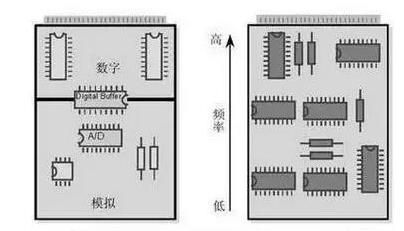Design digital-analog hybrid PCB is very important to understand the following basic concepts. Mastering the basic concepts related to digital-analog hybrid PCB design will help understand the strict layout and wiring design rules that will be formulated later, so that the terminal product will not be easily discounted when designing the digital-analog hybrid design. Execute the important restraint rules. And it helps to flexibly and effectively deal with crosstalk problems that may be encountered in digital-analog hybrid design.

1. The important difference between analog signal and digital signal in anti-interference ability
The digital signal level has a strong anti-interference ability, while the analog signal has a poor anti-interference ability.For example, a digital signal of 3V level can tolerate a crosstalk signal of 0.3V even if it receives a 0.3V signal without affecting the logic state. However, in the field of analog signals, some signals are extremely weak. For example, the receiving sensitivity of a GSM mobile phone can achieve an index of -110dBm, which is only equivalent to an effective value of a sine wave of 0.7uV. Even if the in-band interference noise of the order of UV is received at the front end of the LNA, it is enough to greatly degrade the receiving sensitivity of the base station. This slight interference may come from small noises on the digital control signal line or power ground line.
From the system point of view, digital signals are generally only transmitted on the board or in the frame. For example, memory bus signals, power control signals, etc., as long as the interference received from the sending end to the receiving end
is not enough to affect the judgment of the logic state. The analog signal needs to undergo a series of processes such as modulation, frequency conversion, amplification, transmission, spatial propagation, reception, and demodulation before it can be recovered. During this process, the noise continuously drops to the signal. From a system perspective, it is necessary to ensure that the final signal-to-noise ratio meets the requirements in order to demodulate correctly. The interference comes from the attenuation and noise of space propagation. In order to achieve better communication performance, the crosstalk introduced by the interconnection on the board must be reduced as much as possible. Therefore, it can be considered that the requirements for crosstalk of analog signals are tens of times higher than that of digital signals, and may even reach tens of thousands of times.
2. High-precision ADC and DAC circuits
Ideally, the relationship between the signal-to-noise ratio of linear ADC and DAC circuits and the number of conversion bits is: SNR=10Log(F2/N2)=10Log[A2/2/(A2/3*2n)]=6.02n+1.76 dB
For 14-bit linear ADCs and DACs, if the bit data (LSB) is enabled, the theoretical signal-to-noise ratio can be calculated as 86dBc. Compared with the crosstalk requirement of the digital circuit of about 20dBc, the high-precision 14-bit linear ADCs and DACs The requirements for noise are at least 1000 times higher than for digital signals. Of course, if the effective number of bits is only 11 bits, the crosstalk requirement can be appropriately lowered, but it is still much higher than the requirement for digital signals.The above two situations show that in the digital-analog hybrid single board, the analog circuit is extremely susceptible to interference, which will affect the signal-to-noise ratio and other indicators. Therefore, in the process of digital-analog hybrid single-board PCB design, very high requirements have to be placed on layout and routing
3. Digital signal is a strong source of interference to analog signal
The level of the digital signal is very high compared to the analog signal, and the digital signal contains rich harmonic frequencies, so the digital signal itself is a strong source of interference for the analog signal. In particular, high-current clock signals and switching power supplies are strong interference sources that need to be paid attention to in digital-analog hybrid designs.
4. The fundamental purpose of digital-analog hybrid interconnection design
We can understand the digital-to-analog design problem in this way. For digital circuits, we follow the design rules of digital circuits. In the area of digital circuits, large interference can be allowed, as long as it does not affect the realization of system functions and external EMC indicators. The "larger" we are talking about here is relative to analog circuits. For digital circuits, it is unnecessary and impossible for us to control the existence of crosstalk like analog circuits. For analog circuits, we must follow the design rules of analog circuits, and the allowable interference in the analog circuit area is much smaller than in the digital circuit area. The purpose of digital-analog hybrid interconnection design is to ensure that the interference of digital signals only exists in the digital signal area through reasonable layout, wiring, shielding, filtering, and power supply division.
The content we need to focus on includes interference sources, sensitive circuits, and interference paths. The following will describe the layout and routing principles adopted from these three aspects. Successful digital-analog hybrid single-board design must pay careful attention to every step and every detail in the entire process before it can be realized. This means that thorough and careful planning must be carried out at the beginning of the design, and every design step must be carefully planned. The progress of the work is fully and continuously evaluated. The layout and routing must be carefully checked and verified to ensure 100% compliance with the layout and routing rules. Otherwise, improper routing of a signal
line will completely destroy otherwise very good printed circuit boards. The rules are dead. Only through a deep understanding of the rules can we ensure that we can use the rules correctly and complete the design digital-analog hybrid PCB.